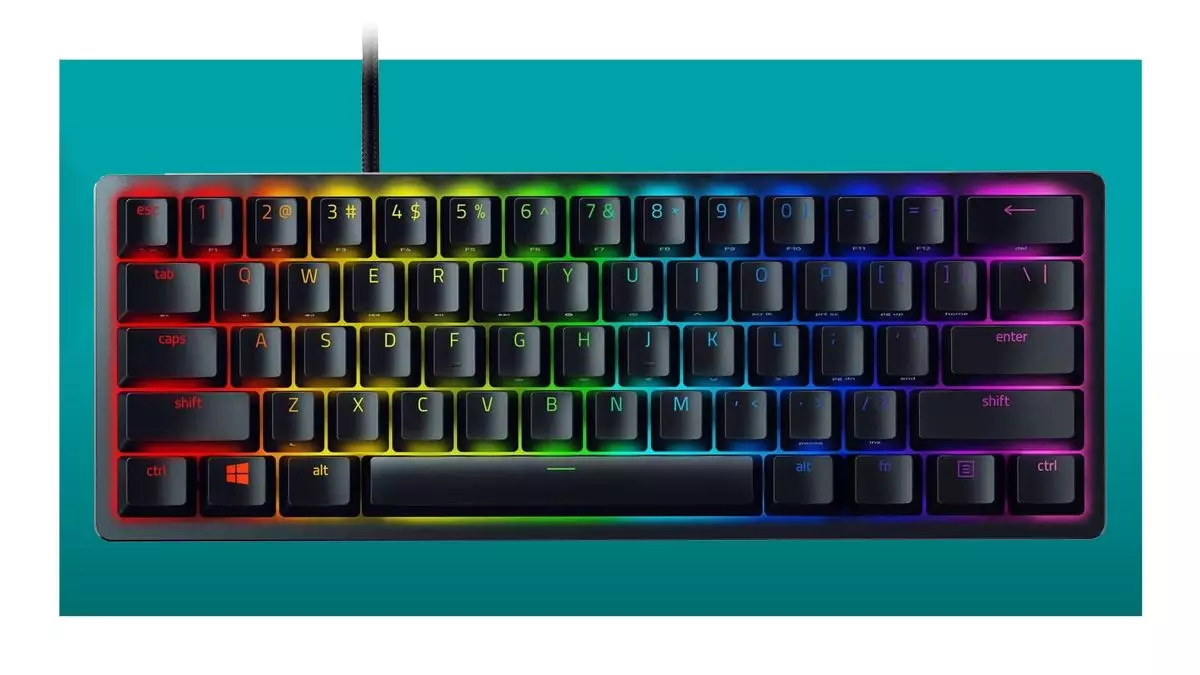In the vast universe of tech enthusiasts, few categories ignite passions quite like mechanical keyboards. Among this elite group, Razer has established itself as a titan, renowned for its innovative designs and high-performance peripherals. Enter the Razer Huntsman Mini, a compact 60% keyboard that has captured the attention of hobbyists and gamers alike—not just for its gaming prowess but also for its undeniable charm. Priced at a tantalizing $70 during the Amazon Big Spring Sale, it showcases a blend of functionality and aesthetics that sparks intrigue. Yet, beneath its cute exterior lies a complex narrative full of trade-offs and user experience dilemmas.
The Allure of Compactness
One of the primary appeals of the Razer Huntsman Mini is its diminutive form factor. With a design that shrinks the traditional keyboard layout down to approximately 60% of its original size, it’s an attractive option for those plagued by restricted desk space. This tiny footprint can transform a cluttered workspace into an organized environment, freeing up room for other peripherals or even space for decorative items—like the ubiquitous Miku Hatsune figures that grace many a fan’s desk.
However, the allure of compactness carries with it a significant drawback. The absence of dedicated function and navigation keys, including the often-utilized arrow keys, can disrupt the workflow of users who depend on these functions for normal productivity. Gesture-driven alternatives, such as employing an ‘fn’ layer to access arrow commands, can feel cumbersome and tactically unresponsive. For casual users or those who value efficiency, these limitations pose serious usability questions that might lead one to wonder: is adorability worth the sacrifice of practicality?
Optical Switches: A Mixed Bag
Another endearing feature of the Huntsman Mini is its optical switch technology. Razer’s proprietary light-based actuation system theoretically allows for quicker response times, providing a smoother typing experience that appeals to gamers seeking accuracy during fast-paced sessions. The clicky variant of the opto-mechanical switches gives a satisfying auditory feedback, making every keypress feel energetic and alive.
However, this excitement is not without its consequences. Users vocal about their experiences have pointed out that while the keyboard effectively registers commands quickly, the clicky sound can become a source of irritation during prolonged use—an acoustic overload when face-rolling keys might create more noise than necessary. Intensive users might find that while the speed is commendable, the auditory feedback may drive them to seek quieter alternatives, especially when working in shared spaces.
Price vs. Performance: Value Proposition Debate
At $70, the Razer Huntsman Mini makes an appealing offer, especially for those on a budget. The significant discount during promotional sales effectively positions it as an attractive entry point into the world of mechanically active keyboards. However, the financial allure raises a critical concern: does the Razer Huntsman Mini deliver value commensurate with its price tag?
While there is no denying the keyboard’s aesthetic appeal and its niche performance capabilities leans towards the positive, real-world functionality often diverges from editorial praises. For instance, while compact keyboards can be quantified as portable and space-efficient, the limitations in navigation and function usability may frustrate some users to a degree that outweighs these advantages. In essence, the Razer Huntsman Mini personifies the classic debate of quantity over quality, leaving potential buyers to consider what they value more in their typing experience.
A Balancing Act for the Enthusiast
Ultimately, the Razer Huntsman Mini serves as an illustrative case study of contradictions within the gaming peripheral realm. It is charming, yes, but also fraught with practical challenges that turn some users away. Ideal for gamers looking for a compact companion in a setup defined by aesthetic appeal, it simultaneously risks alienating those who require a more functional keyboard for daily use.
As desktop culture evolves, the journey of the Razer Huntsman Mini highlights how sometimes the battle between functionality and stylishness is not easily resolved. It’s a delightful addition for select individuals, though for others, it serves as a cautionary tale of prioritizing design over usability. The test of time will reveal whether the Huntsman Mini will find a comfortable niche within the hearts—and on the desks—of those who straddle this fine line between utility and charm.

